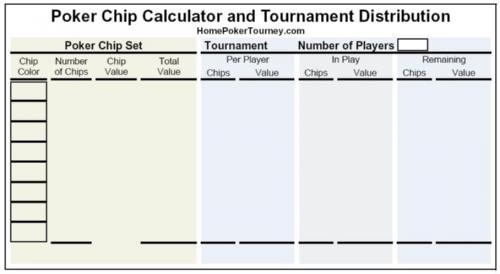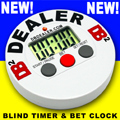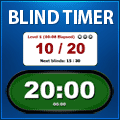|
|
How Many Poker Chips Do I Need?This page describes how many poker chips you need to run a no-limit Texas Hold'em poker tournament and how many poker chips to give each player at the beginning of the game. It also describes standard poker chip colors and poker chip denominations. The information on this page is geared towards holding a poker tournament of ten to twenty players. For information about the poker chip distribution for a large poker tournament of 100 players or more, please visit my Large Tourneys page. There are several factors to consider before buying your set of poker chips. The composition of your poker chip set breakdown will depend on the type of poker that you will be hosting, such as hold'em, stud, or even non-tournament cash games, and the amount of your buyin (starting chips). Tournaments with a 100-chip buyin will use different colored chips than a tournament with a 10,000 chip buyin. The chips that you will need for a limit game differ slightly from the chips that you will need for a no-limit game. This page assumes that you are playing a no-limit Texas Hold'em poker tournament. See my Ring Games page for information about how to buy poker chips for a cash game. Number of PlayersIn general, you should own about 500 poker chips, in three or four different colors, to host a 10-player poker tournament and you should own about 1000 chips, in four or five different colors, to host a 20 to 30-player tournament. Please view the charts shown below for more precise information about the number of poker chips to issue each player and the total number of chips needed to run a poker tournament. Keep in mind that allowing players to rebuy means that you will need even more poker chips than what was initially issued to each player at the start of the tournament. The good news about rebuys is that you can usually just issue a couple high-denomination chips (2x$500) to the player who is rebuying and request that they make change from other players at the table to obtain smaller-denomination chips. You will also need some large-denomination chips ($500, $1000) to assist in issuing rebuys and for performing a chip color-up. Your Buyin AmountThe chip colors that you should normally use for a T100 tournament are different than the chip colors that you should use for a T10,000 tournament. A T100 tournament requires lots of low-valued $1, $2, and $5 chips, which should normally be white, blue, and red in color - these are also good colors if you intend to hold low limit cash games. A T10,000 tournament requires lots of $100, $500, and $1000 chips, which should normally be black, purple, and yellow/orange in color. Before you purchase your poker chip set, you should decide what tournament buyin you will use and purchase your poker chip colors accordingly. Purchase traditionally low-value colors of white, blue, red, and green if you are hosting a tournament with a buyin of 100 chips. Purchase mid-value colors of red, green, black, and purple if you are hosting 1000 chip buyin tournaments and purchase high-value colors of green, black, purple, yellow, and grey if you are hosting 10,000 chip buyin tournaments. Standard Poker Chip Colors
There are no "standard" rules for determining the color and denomination of poker chips. In general, each casino can use it's own colors, although some jurisdictions do limit the colors that may be used. New Jersey has a written set of rules for poker chip colors and denominations. The chart to the left shows the most common poker chip colors and denominations. You should try to use these colors whenever possible - it's always nice to show up at a poker room and discover that they use standard poker chip colors and standard poker rules. White poker chips are usually used to denote a value of $1. Blue chips are usually used to denote a value of $2 but are sometimes used as $10 chips. Pink chips are commonly used in blackjack to denote $2.50 and
are sometimes used in poker to denote large denominations. Red chips are usually $5. Green chips are usually $25 (sometimes $20) and black chips are $100. Colors for poker chips above the $100 black chip
are even less standardized than the lower-denomination chips. Purple or lavender chips are used for $500 and yellow or
orange are used for $1000. Grey or blue chips are sometimes used as $5000 chips. How Many Poker Chip Colors Do I Need?You only need three or four different poker chip colors. The ratio of colors needed for a no-limit poker tournament should be something like 4/3/2/1, meaning that you should buy a ratio of 4 chips of your lowest denomination, 3 chips of your next denomination, 2 chips of your next denomination, and 1 chip of your highest denomination. If you are purchasing 1,000 poker chips - you should buy 400 chips of your lowest denomination ($5), 300 chips of your next denomination ($25), 200 chips of your next denomination ($100), and 100 chips of your next denomination ($500). If you are purchasing 500 chips - you should buy 200/150/100/50 chips. You need more of the lower-denomination chips than higher-denomination chips. Your tournament will begin with a large number of players, each making small bets because of the low blinds at the start of a tournament. You will need lots of lower-denomination chips to accommodate the large number of players making all these small bets. As your tournament progresses, players will drop out and the blinds (and bets) will increase in value. The middle stages of your tournament will consist of a medium number of players making medium-sized bets. The end of your tournament will consist of a few players making high-sized bets. This means that overall, you will should own numerous low-valued chips, less medium-valued chips, and only a few high-valued chips. Keep in mind that you will also require some additional high-denomination chips to issue rebuys and perform chip color-ups. The 4/3/2/1/ chip distribution ratio is not "standard" but is a good starting point for setting up your poker chip set. The important thing is to match your set to the buyin and blinds that you plan to use for your tournaments. If you only want three poker chips colors - a 4/3/2 ratio is fine, but adding a fourth color will help with color-ups and rebuys. A 2/2/1 split might be acceptable, especially if you play a lot of cash games. Some poker chip retailers will allow you to buy individual chips in any color, but most poker chip suppliers sell chips in packages (rolls) of 50 chips of one color. This means that you might not be able to buy 10 or 25 chips of a certain color - you will probably have to buy at least 50. Too Many Poker Chip Colors!Purchasing too many colors of poker chips can actually harm your ability to host a poker tournament - you might not have enough chips in any one color to issue to all your players. If you find that you have too many colors of chips, you can combine two colors together and use them both as the same denomination - you can make the red and pink chips both worth $5. A poker chip set of 500 chips in five different colors (100-100-100-100-100) means that if you have ten players - you cannot issue each player more than 10 chips of any one color. In cases like this, it is best to flatten your chip colors and denominations to suit your numerous colors. Instead of using chip colors and denominations of $5/$25/$100/$500 you can try to use $5/$10/$25/$100. Issue your players some $10 chips to replace some of the $5 and $25 chips. How Many Poker Chip Denominations Do I Need?In general, your denominations (1, 5, 25, 100, 500, 1000, etc.) should increase in increments of four or five. If your lowest valued chip is $1, your next denomination should be $5, then $25, then $100, then $500, etc.. Having chip denominations that are too close in value does not make good use of your poker chip set - a player can easily use two $5 chips instead of one $10 chip. Your chip denominations must match the buyin and blinds schedule that you use for your tournament. If you host a tournament where each player starts with 100 chips (T100) - your chip denominations should probably be 1, 2, 5, and 25. If you host a tournament where each player starts with 1000 chips - your chip denominations should probably be 5, 25, 100, and 500. If you host a T10,000 tournament - your chip denominations should probably be 25, 100, 500, and 1000. Your lowest-denomination chip will be determined by your blinds schedule and your antes (if used). If your blinds levels include amounts such as $5/$10 - you will need $5 chips in your game. If your lowest blinds level is $100/200 - your lowest denomination might be $100. If you use antes in your game, you will probably require some $25 chips in the mid/late portion of your game. If you are playing limit poker, as opposed to no-limit poker, you will need low-denomination chips for the small blind. In a $5/$10 limit game the small blind is usually $2, meaning that you must issue some $2 chips to each player. Do not get denominations ($5, $100) printed on your chips as these numbers might be meaningless 100 years from now when you pass your poker chips on to your great-great-grandson. Instead, hang a poster on the wall, within view of your poker table, showing the chip values. This will allow you to alter the chip values as needed - you can play a T100 tournament or a T10,000 buyin simply by changing the poster hanging on the wall. How Many Poker Chips to Issue Each PlayerYou must issue each player enough chips so that they are not constantly making change from other players or from the dealer. Each player should start the tournament with stacks of about 30 to 50 chips. This will also give your players the feeling of being a 'player' with a 'huge stack' of chips. You can stack and restack your chips, you can shuffle them, spin them, twirl them, and intimidate your opponents with them! It's fun to play with a huge stack! If players begin a tournament with $10,000 in chips but are issued only one $5000 chip and five $1000 chips, they will feel almost broke! They've got a measly six poker chips in front of them! If there are only a few chips in front of a player, there seems to be a psychological barrier to releasing chips into the pot. Having numerous chips seems to make a player more willing to gamble. You want your players to start the tournament with a mountain of chips in front of them. A player who has fifty $100 chips seems more willing to bet a couple hundred chips than a player who has only five $1000 chips sitting in front of them. In general, you should issue each player the same 4/3/2/1/ ratio of chips that you should use to purchase your entire poker chip set. Issue many low-value chips which are needed for the small blinds (and the small increases in blinds) that occur at the beginning of a poker tournament. Issue less of the next higher denomination, and even less of the highest value chips. Why the high number of starting chips per player? If you do not issue enough starting chips, the players will constantly be making change from each other and this can be quite bothersome. You will probably start your blinds at 10-20 or 25-50 meaning that you will use plenty of Red (5) or Green (25) chips right from the very first bets. You won't require as many higher value chips since the total number of players remaining in the game will decrease. High-denomination chips are needed to perform chip color-ups and also add a bit of excitement to your game when they make their appearance. Purple (500) or Yellow (1000) chips make it much easier to increase your buyin to 1500, 2000, or even 10,000 chips, instead of 1000. High-denomination chips also make it easier to issue rebuys - simply hand the rebuy player a couple Purple (500) chips and let him make change from other players. Poker Chip DistributionsHere are several poker tournament chip distributions. The numbers in red are the number of chips issued to each player at the start of the tournament ...
Purchasing 500 Poker ChipsUsing a 4/3/2/1/ ratio results in a 500-chip set of 200/150/100/50. This is probably the best overall breakdown for 500 poker chips. The colors that you choose should be determined by your tournament buyin amount - red/green/black/purple for T1000 tournaments and green/black/purple/yellow for T10,000 tournaments.
Purchasing 1,000 Poker ChipsUsing a 4/3/2/1/ ratio results in a 100-chip set of 400/300/200/100. This is probably the best overall breakdown for 1000 poker chips. The colors that you choose should be determined by your tournament buyin amount - red/green/black/purple for T1000 tournaments and green/black/purple/yellow/grey for T10,000 tournaments.
Other Poker Chip DistributionsFeel free to alter the above chip distributions. Some people prefer a 2/2/1 distribution such as 200-200-100 or even 200-200-50-50. All these chip distributions are fine and you should be able to adapt one of my suggested poker chip distributions for your own poker chip set, no matter how it is distributed. Purchasing 600 ChipsIf you are purchasing a 600-chip set, you should consider purchasing more of the mid-to-high valued chips. Purchase another 100 Black (100) chips for a T1000 set and another 50 Black (100) and 50 Purple (500) chips for a T10,000 set. T100 Tournaments or Cash GamesIf you play in low buyin tournaments (100 starting chips) or plan to use your poker chips to host cash games (as opposed to tournaments) you might consider purchasing white (1) and blue (2) chips, but in general, these colors are not used in large buyin tournaments. Poker Chip CalculatorHere is a poker chip calculator to help you test your poker chip distribution for poker tournaments. The calculator will assist in testing different combinations of poker chip colors and denominations. The calculator makes it easy to determine the total value of your poker chip set, how many chips can be issued to each player, and how many chips remain in your set. |
||||||||||||||||||||||||||||||||||||||||||||||||||||||||||||||||||||||||||||||||||||||||||||||||||||||||||||||||||||||||||||||||||||||||||||||||||||||||||||||||||||||||||||||||||||||||||||||||||||||||||||||||||||||||||||||||||||||||||||||||||||||||||||||||||||||||||||||||||||||||||||||||||||||||||||||||||||||||||||||||||||||||||||||||||||||||||||||||||||||||||||||||||||||||||||||||||||||||||||||||||||||||||||||||||||||||||||||||||||||||||||||||||||||||||||||||||||||||||||||||||||||||||||||||||||||||||||||||||||||||||||||||||||||||||||||||||||||||||||||||||||||||||||||||||||||||||||||||||
Online Poker Guide
Hand Converter
Holdem strategy
Freeroll tournaments
Poker calculator
Online poker
Poker rooms
> poker pokeren
> iDeal poker
> online casino
> iDeal casino
> casino casinos
> casino bonus
Get Bonus code Titan Poker, and full tilt poker referral code or max bonus to the full tilt referral code. Best ultimate bet referral code sign up bonus doyles room promo code or poker host bonus code

























